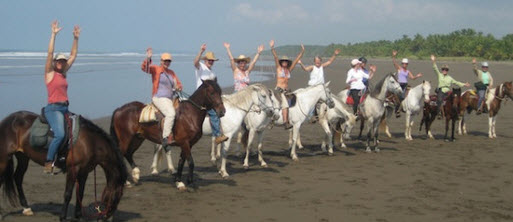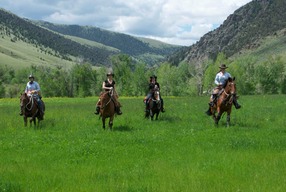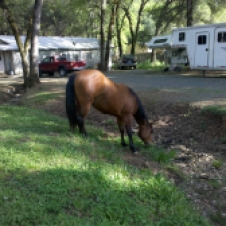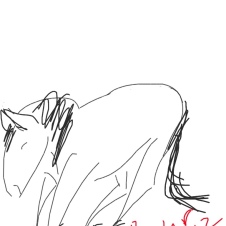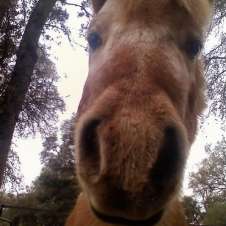I am taking lessons now with my barn manager/landlord Erin Murphy, and I have already learned so much in just two sessions. We’re not using Rocky because his feet are too sore (countdown to next trim/measuring for boots … 18 days). On Tuesday I got to play with Dave, an “impulsive” LBE, and today I played with Parker, a “dull” LBI. Both are very nice, friendly horses who have lived in Parelli circumstances with Parelli humans for years — Dave for his whole life, and Parker at least for several years although I don’t know his life story.

Parker, chocolate palomino Rocky Mountain Horse
In both sessions, the main theme was energy. Specifically, my energy, and how the horse relates to it.
On Tuesday, Dave was hardly impulsive at all, and in fact appeared a little “lazy” (for him). Erin pointed out that if I was nervous about a horse going too fast, which I have been at times, I might be subconsciously holding in my energy rather than sending it out even though I’m waving the stick as if to say “go!”
That’s a central theme of natural horsemanship: the horse responds to what you’re actually doing, not what you think you’re doing. (Pat-isms: 1 – “Horses are like computers. They never do what you want but they always do what you say.” and 2 – “To a horse, everything means something and nothing means nothing.” )
So today with Parker, she worked with me on how to bring my energy up effectively (hard!) and down (easier!) and create responsiveness and life in the horse. I practiced a long phase 1 with energy and intention, and then a meaningful phase 4 to back it up, so that he would tune in and believe my phase 1. And you know what? It worked. He went from “ho hum, maybe if I shift my weight to my other foot, she’ll think I’m going to send, and then I can just stand here” to “Yes, ma’am, thank you for sending me!”
It’s not that he’s dull and always going to be dull, it’s that it takes savvy to engage him. When he’s engaged he’s responsive and clever and all those things you want a horse to be. Judicious application of cookies (LBI!) and resisting my urges to do friendly game or pet him in between made a huge difference. He became very light and responsive to subtle signals.
That’s a big learning experience, for me, not to follow up automatically with friendly game and/or petting. “What is the purpose of Friendly Game?” Erin asked. I thought about it, not wanting to parrot back the PNH materials but actually answer what it means to me. I said it’s twofold. One is to desensitize the horse to stimuli that doesn’t need to be meaningful to him. The other is reassurance.
“Does he need reassurance right now?” she asked. He didn’t. He was resting, relaxed, eyes half-lidded. She said that too much friendly game at the wrong time can make a horse dull. That we’re trying to sensitize him, to encourage him to be light, not to desensitize him. It was good that I “rubbed out the sting” after a phase 4 that made him a little nervous.
But I didn’t need to run my rope all over him and pet him when he wasn’t — it was better to take off all pressure, turn my energy away from him, and do a full release, rather than put him in a position where he had to retreat inward (“get dull”) to ignore stimuli he didn’t want or need.
Even in just that session, the dynamic changed when I did that. He tuned in more, I got more clear with my energy (thank you my former life when I practiced Pilates and took some dance classes!), and I got exuberant sends and energetic sideways and lots of perked ears and eyes in my direction. I paid close attention to engaging my core and at one point during sideways I realized I was wiggling the stick but my core was cringing backwards — I don’t know Parker well and I suddenly had this “what if he kicks” moment — and that really shows that the horses tune in more to the energy than to the tools, because he let the energy out of his body and sort of muffled to a stop, rather than get more exuberant with his sideways. Hm, how interesting!
I know I’m in a habit with Rocky of petting him and friendlying him a lot and I get all “oh isn’t he cute” and squiggly. He does ask for reassurance more often than Parker did today, so it’s not like I’m always forcing Rocky to put up with stroking he doesn’t want. But Erin said to remember it’s about what the horse needs, not about whether I want to pet him every five seconds. Putting the horse’s needs first can mean not overdoing petting, friendly, hugging, and the like, and not doing it at the wrong time.

Rocky wondering if I'm going to snuggle during dinner
I have recently started doing more “functional” touch, like flicking the string around like it’s my tail and I’m a companion horse keeping flies off Rocky. And letting Rocky initiate touch, not barging into his space and petting and brushing and all that.
Because, ya know, I don’t like to be touched. I’ve been nervous about the next Grief Release Workshop session because we’re going to practice acupressure on each other and I hate the thought of having to touch and be touched by these women I barely know. When I’ve had lovers who are naturally touchy-feely all the time, we’ve always had to learn to balance each other: me to relax into random touching and them to back off a bit so that I have space to breathe and ask for touch when I want it. (I don’t mean sex, that’s not a problem; I mean random petting and stroking and brushing and playing with my hair which I can barely tolerate even on my most cuddly days.)
My horse is my mirror. Wow.

